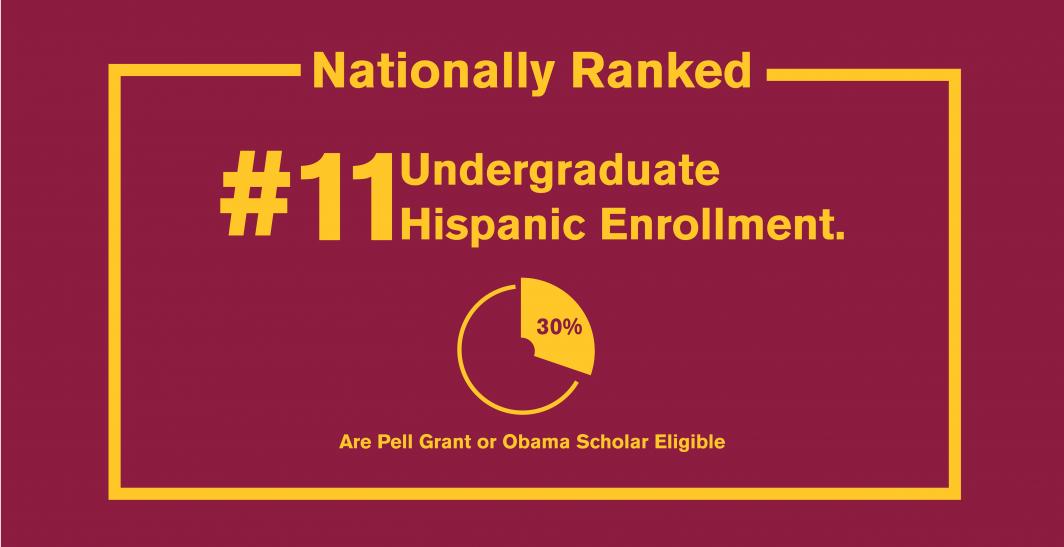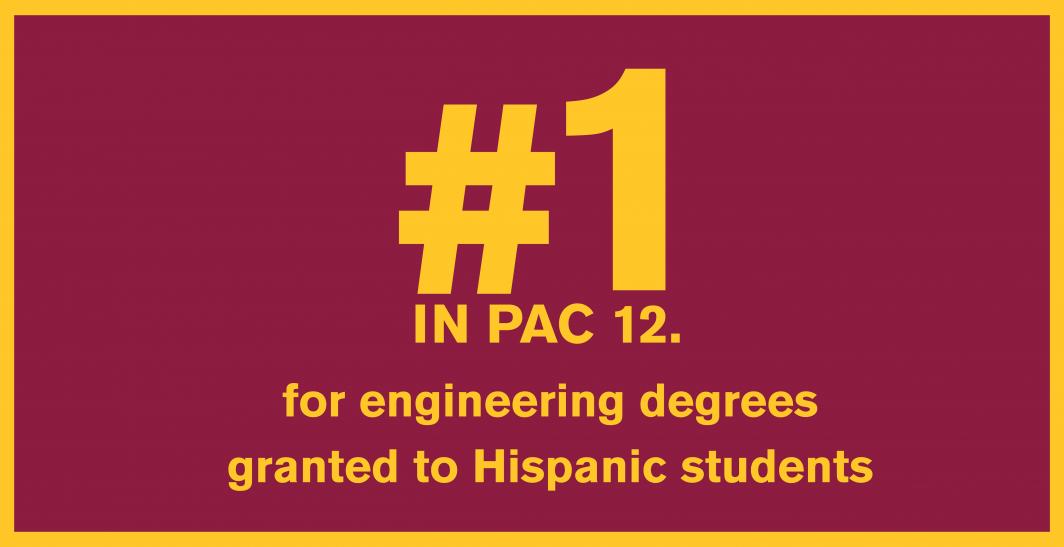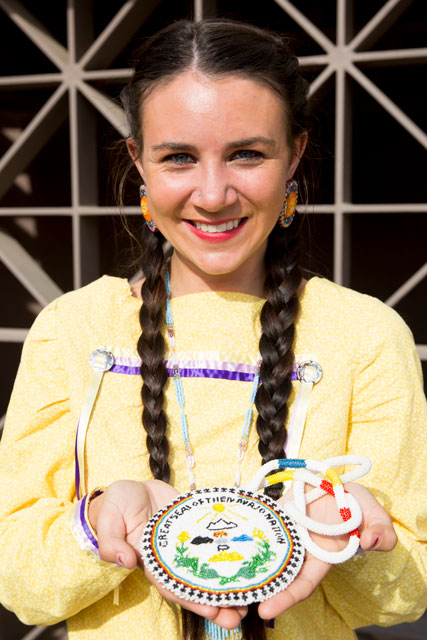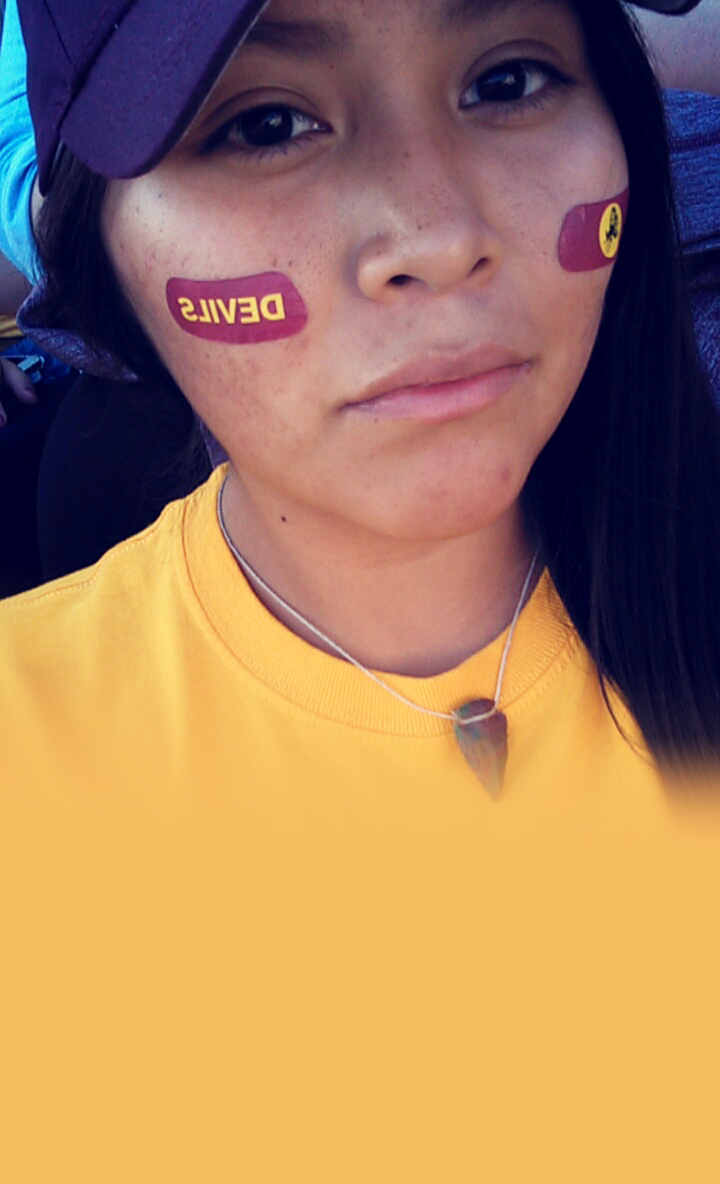Editor's Note: This is part one of a three-part series. Access the introduction and additonal sections.
Making strides
The Ira A. Fulton Schools of Engineering boast a growing minority population, including Hispanic, Native American and African American students, which are traditionally underrepresented groups in science and engineering. Among these students are 4.0 achievers, student org leaders, volunteer coordinators, entrepreneurs and undergraduate researchers — and many of Arizona State University’s best and brightest.
The Fulton Schools approach to engineering education emphasizes the power that comes from a creative, innovative, boundary-stretching engineering student populace. To this end, the faculty and administration nurture programs that increase gender and ethnic diversity in the graduating student population and create an environment in which they can succeed. These programs, combined with scholarships geared toward attracting diverse populations, make ASU’s engineering community broader and richer.
Hundreds of these students are supported and empowered through involvement in engineering student organizations, including the ASU chapters of the American Indian Science and Engineering Society, Latinos in Science and Engineering, National Society of Black Engineers, Society of Asian Scientists and Engineers, Society of Hispanic Professional Engineers, and Construction in Indian Country. In addition, programs such as Engineering Projects in Community Service, the Fulton Undergraduate Research Initiative and the Grand Challenge Scholars Program seek to bring bright young minds from different backgrounds to solve problems, find solutions and learn together.
Leaders in the Fulton Schools aren’t interested in missing out on a single game-changing solution, and are actively changing the face of engineering in their desire to better the world through outstanding engineering achievement.

Through their eyes
Kayla Devault, master’s student, mechanical engineering
Originally from Pennsylvania, but now living in Window Rock, Arizona — the Navajo Nation’s capital city — graduate student Kayla DeVault has long been swept up with a spirit for advocacy.
In November she traveled to Morocco to represent SustainUS, ASU and her Native American citizenship (enrolled Shawnee and Anishinaabe) at The United Nations Framework Convention on Climate Change (UNFCCC) COP 22. At the event, she will enhance discussions on climate change and policy-making with her research background in renewable energy on the Navajo Nation.
“It is a fantastic opportunity for youth and young adults to gain exposure to the entire policymaking process, to unite for a cause we are passionate about, and to lead a campaign to promote the recommendations we collectively agree upon,” said DeVault, who joined SustainUS, a youth-led organization advancing justice and sustainability through advocacy, several years ago.
DeVault is pursuing a master’s degree in mechanical engineering, focusing her research on alternative energy and tribal policies regarding environmental stewardship.
“I am interested in how to make tribal nations stronger contenders in a sustainable world,” DeVault said.
DeVault is an appointed member of the EPA’s NEJAC Youth Perspectives on Climate Working Group and was nominated as a Sequoyah Fellow last year by the American Indian Science and Engineering Society.
“I am a huge fan of combining cultural wisdom with technical knowledge,” said DeVault, adding that she enjoys working “in both of these worlds” and thinks the two complement each other.
“Western technology and systems can help quantify the wisdom tribes already have,” she said, citing climate change as a good example. “It’s all about balance, global family and responsibility.”
DeVault says the transition to ASU was not without challenges, including a brief stint of living out of her car and the difficult commute from the reservation to Tempe campus.
In particular, she said early support from Marc Mignolet, a professor and graduate program chair in mechanical and aerospace engineering, was so incredible that she turned down her acceptance to the Colorado School of Mines to enroll at ASU.
“Dr. Patrick Phelan, too, has done some amazing things for me. He is enthusiastic about the project I picked for his solar thermal engineering class and genuinely appreciates traditional knowledge and how I strive to blend it with engineering,” DeVault said.
After graduation DeVault plans to pursue a doctoral degree and to either conduct research or teach part time at a tribal college, as well as to continue to work in tribal policy and research related to energy and climate.
Did we mention she also finds time to excel on ASU’s women’s ice hockey team?
Jalen Knows, junior, civil engineering
Jalen Knox had an illuminating moment while attending the 42nd Annual National Society of Black Engineers Convention in Boston earlier this year.
After attending the convention, Knox said he realized that he wasn’t pursuing an engineering degree solely for himself, but also to benefit the black community and NSBE as a whole.
Knox is a civil engineering junior from Litchfield Park, Arizona, and the current treasurer of the NSBE ASU Chapter.
After the beneficial experience he had in Boston, Knox is now helping to mount a campaign to finance attendance for ASU students at next year’s annual convention in Kansas City, Missouri.
In addition to involvement with NSBE, Knox has enhanced his undergraduate experience by serving as an undergraduate teaching assistant for two semesters and as a community assistant in the residential community.
After assisting with the CEE 210 (Statics) course, Knox said, “Being a UGTA enhanced my knowledge of structural analysis and was a great opportunity for me to hone my communication skills and to be a tutor for others.”
Knox said scholarships and family support enabled him to excel at ASU. In addition, “the Fulton Schools has an ample amount of information specifically geared towards undergraduates such as internships and networking opportunities.”
In particular, Knox says his engineering education has been enhanced by the mentorship of his fluid mechanics professor Giuseppe Mascaro. In the spring, Knox will conduct undergraduate research as part of the Fulton Undergraduate Research Initiative under Mascaro, and says Mascaro played a role in convincing him to pursue a master’s degree specializing in hydrosystems engineering through the Fulton Schools Accelerated 4+1 program following completion of his studies to earn a bachelor’s degree in 2017.
After graduation, Knox plans to join a company that specializes in water resources, water treatment or water management. He hopes to devote his time to a good company and to eventually obtain a leadership position.
All in all, Knox has had access to a quality education that he feels many African Americans unfortunately lack.
He believes that part of the problem might be that engineering isn’t advertised in black communities as much as other career paths, such as athletics.
“To enroll more African American students the importance of education must be stressed more and the educational system in America’s inner cities must be improved tremendously,” Knox added.
María José Quezada, senior, biomedical engineering
María José Quezada — known around campus as “Joe” — is an international student from Mexico City who has been a leader in coordinating efforts for Hispanic and Latino students young and old.
Now a senior nearing graduation from Arizona State University, she has had no shortage of involvement in academic and campus life.
As an engineering peer mentor, she helped dozens of freshmen students to connect with a strong campus community and important student resources. As an E2 Camp Counselor she welcomed students to the Ira A. Fulton Schools of Engineering at an overnight orientation replete with games and networking activities.
And her achievements as an undergraduate researcher interested in neurorehabilitation can’t be ignored.
As part of the Fulton Undergraduate Research Initiative, Quezada has conducted research in the Human Mobility Lab for several semesters, with a focus on the effect of startle reflex in stroke rehabilitation therapy.
She also earned a 10-week spot at an MIT Summer Research Program in which she adapted the Microsoft Kinect game interfaces for MIT Skywalker robot for cerebral palsy and stroke patients gait rehabilitation.
“There is a lot to discover and understand about the way our brain communicates with our body to perform functional tasks,” said Quezada, who plans to pursue a doctoral degree in biomedical engineering and physical therapy to develop better technology and therapeutic tools.
She is also on track to graduate as a Grand Challenge Scholar, a unique designation earned through the completion of innovative curriculum and highly involved research experiences, including entrepreneurial, global and service learning opportunities.
But perhaps most meaningful is her involvement with the Society of Hispanic Professional Engineers (SHPE de ASU) student organization.
As president, she oversees 70 active members and 110 national members. The student organization coordinates social and sporting events, study sessions, as well as industry and professional workshops with companies such as Intel and Texas Instruments.
“Last year, we launched our MentorSHPE program with professionals from SHPE Phoenix to enable students to build a strong relationship with an industry professional that can guide decisions throughout college and after graduation,” Quezada said.
She says a key feature of SHPE de ASU is its impact on the community. In addition to working with the local Sí Se Puede Foundation, the student organization hosts Noche de Ciencias (“Science Night”) at local elementary schools, middle schools and high schools once every semester.
The event features a fun engineering challenge for young students and provides parents with information about how to prepare their kids for college.
“Outreach programs like the ones organized by SHPE de ASU have a great impact on students’ decisions. If young underrepresented minority students can see older engineering students who look like them, they will be able to relate and hence work toward reaching the place where we are at,” Quezada said.
Robyn Haskey, junior, construction management
Construction management junior Robyn Haskey, who is full-blooded Navajo, says student organizations, diversity programming resources (in particular, American Indian Student Support Services) and advisors played an important role during her tough transition from life on the reservation to one of the biggest public schools in the country.
“I am the first in my family to attend college and move away from the reservation, where I had grown up my entire life. I was alone and afraid,” Haskey admited.
However, through organizations like Construction in Indian Country (CIICSO) and the American Indian Science and Engineering Society (AISES) she was able to manage the transition.
“Transitioning from life on the reservation to life at a four-year university, let alone a city, was made easier with my new support system,” she said.
Eventually moving from club member to co-president of CIICSO, the student organization has played a prominent role in Haskey’s success as an engineer, connecting her with advisors and “a unique support system of Native peers who are pursuing a similar degree,” says Haskey.
“If I did not have the support system, I do not believe I would have made it this far into my college education. I believe a lot of Native American students who drop out do so because they lost the focus and motivation it takes to pursue a degree. With my support system, I am given a constant flow of motivation to continue my education,” Haskey said.
Her interest in construction management was sparked in a high school class. She is also pursuing an American Indian Studies minor and is a student in Barrett, the Honors College.
After graduation, she aims to travel the country and continue to see the world outside of her reservation. She is also considering joining the U.S. Army Reserve’s construction and engineering division.
Though in the end she has plans to return to her homeland, with hopes to use her new knowledge and experiences to improve living conditions on the reservation.
“On reservations, it is not uncommon for many Native elders and families to live in rural areas without running water, electricity and a means of transportation. I believe improving the infrastructure on reservations would improve the ability of reservations to help lower unemployment and poverty rates, and hopefully improve high school graduation rates,” Haskey said.

More Science and technology

ASU and Deca Technologies selected to lead $100M SHIELD USA project to strengthen U.S. semiconductor packaging capabilities
The National Institute of Standards and Technology — part of the U.S. Department of Commerce — announced today that it plans to…

From food crops to cancer clinics: Lessons in extermination resistance
Just as crop-devouring insects evolve to resist pesticides, cancer cells can increase their lethality by developing resistance to…

ASU professor wins NIH Director’s New Innovator Award for research linking gene function to brain structure
Life experiences alter us in many ways, including how we act and our mental and physical health. What we go through can even…




